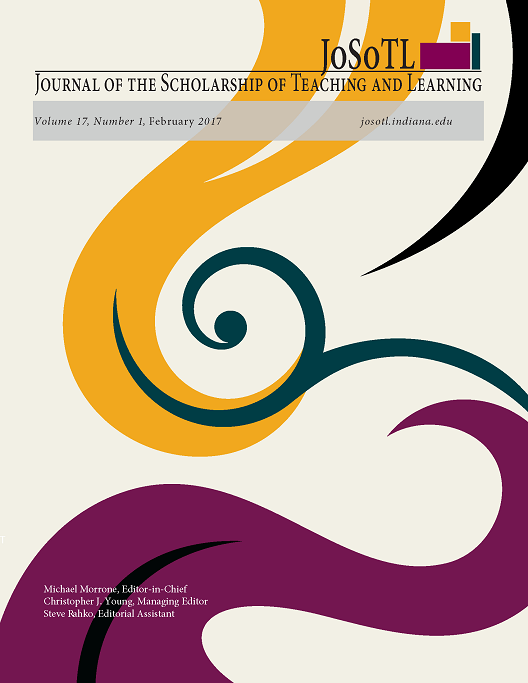Student engagement in a compulsory introductory physiology course.
Main Article Content
Abstract
Downloads
Article Details
- Authors retain copyright and grant the Journal of the Scholarship of Teaching and Learning (JoSoTL) right of first publication with the work simultaneously licensed under a Creative Commons Attribution License, (CC-BY) 4.0 International, allowing others to share the work with proper acknowledgement and citation of the work's authorship and initial publication in the Journal of the Scholarship of Teaching and Learning.
- Authors are able to enter separate, additional contractual agreements for the non-exclusive distribution of the journal's published version of the work (e.g., post it to an institutional repository or publish it in a book), with an acknowledgement of its initial publication in the Journal of the Scholarship of Teaching and Learning.
- In pursuit of manuscripts of the highest quality, multiple opportunities for mentoring, and greater reach and citation of JoSoTL publications, JoSoTL encourages authors to share their drafts to seek feedback from relevant communities unless the manuscript is already under review or in the publication queue after being accepted. In other words, to be eligible for publication in JoSoTL, manuscripts should not be shared publicly (e.g., online), while under review (after being initially submitted, or after being revised and resubmitted for reconsideration), or upon notice of acceptance and before publication. Once published, authors are strongly encouraged to share the published version widely, with an acknowledgement of its initial publication in the Journal of the Scholarship of Teaching and Learning.
References
Allers, N. (2010). Teaching physiology to dental students: matching teaching and learning styles in a South African dental school. Journal of Dental Education, 74, 986-992. http://www.jdentaled.org/content/74/9/986.full.pdf+html
Armbruster, P., Patel, M., Johnson, E., & Weiss, M. (2009). Active learning and student-centered pedagogy improve students attitudes and performance in introductory biology. CBE Life Sciences Education, 8, 203-213. http://www.lifescied.org/content/8/3/203.full.pdf+html
Brown, P.J. (2010). Process-oriented guided-inquiry learning in an introductory anatomy and physiology course with a diverse student population. Advances in Physiology Education, 34, 150155. http://advan.physiology.org/content/ajpadvan/34/3/150.full.pdf
Eagleton, S., & Muller, A. (2011). Development of a model for whole brain learning of physiology. Advances in Physiology Education, 35, 421-426. http://advan.physiology.org/content/ajpadvan/35/4/421.full.pdf
Eberlein, T., Kampmeier, J., Minderhout, V., Moog, R.S., Platt, T., Varma-Nelson, P., White, H.B. (2008). Pedagogies of engagement in science: a comparison of PBL, POGIL, and PLTL. Biochemistry and Molecular Biology Education, 36, 262-273. http://onlinelibrary.wiley.com/doi/10.1002/bmb.20204/epdf
Ernst, H., & Colthorpe, K. (2007). The efficacy of interactive lecturing for students with diverse science backgrounds. Advances in Physiology Education, 31, 41-44. http://advan.physiology.org/content/ajpadvan/31/1/41.full.pdf
Matheson, C. (2008). The educational value and effectiveness of lectures. Clinical Teacher, 5, 218– 221. http://onlinelibrary.wiley.com/doi/10.1111/j.1743-498X.2008.00238.x/epdf
Handelsman, M.M., Briggs, W.L., Sullivan, N., & Towler, A. (2005). A measure of college student course engagement. The Journal of Educational Research, 98, 184-191.
Henige, K. (2012). Use of concept mapping in an undergraduate introductory exercise physiology course. Advances in Physiology Education, 36, 197-206. http://advan.physiology.org/content/ajpadvan/36/3/197.full.pdf
Herrmann, K.J. (2013). The impact of cooperative learning on student engagement: Results from an intervention. Active Learning in Higher Education, 14, 175-187. http://alh.sagepub.com/content/14/3/175.full.pdf+html
Higgins-Opitz, S.B., &Tufts, M. (2010). Student perceptions of the use of presentations as a method of learning endocrine and gastrointestinal pathophysiology. Advances in Physiology Education, 34, 75-85. http://advan.physiology.org/content/ajpadvan/34/2/75.full.pdf
Higgins-Opitz, S.B., & Tufts M. (2014). Performance of first-year health sciences students in a large, diverse, multidisciplinary, first-semester, physiology service module. Advances in Physiology Education, 38, 161-169. http://advan.physiology.org/content/ajpadvan/38/2/161.full.pdf
Huang, A.H., & Carroll, R.G. (1997). Incorporating active learning into a traditional curriculum. Advances in Physiology Education, 18(1), S14-S23.
Kuh, G.D., Cruce, T.M., & Shoup, R. (2008). Unmasking the Effects of Student Engagement on First-Year College Grades and Persistence. The Journal of Higher Education, 79, 540-563. https://muse.jhu.edu/journals/journal_of_higher_education/v079/79.5.kuh.pdf
Levett-Jones, T., Andersen, P., Reid-Searl, K., Guinea, S., McAllister, M., Lapkin, S., Palmer, L., & Niddrie, M. (2015). Tag team simulation: An innovative approach for promoting active engagement of participants and observers during group simulations, Nurse Education in Practice, http://dx.doi.org/10.1016/j.nepr.2015.03.014
Michael, J., & McFarland, J. (2011). The core principles (“big ideas”) of physiology: results of faculty surveys. Advances in Physiology Education, 35, 336-341. http://advan.physiology.org/content/ajpadvan/35/4/336.full.pdf
Michael, J., McFarland, J., & Wright, A. (2008). The second Conceptual Assessment in the Biological Sciences Workshop. Advances in Physiology Education, 32, 248-251. http://advan.physiology.org/content/ajpadvan/32/3/248.full.pdf
Michael, J., Modell, H., McFarland, J., & Cliff, W. (2009). The “core principles” of physiology: what should students understand? Advances in Physiology Education, 33, 10-16. http://advan.physiology.org/content/ajpadvan/33/1/10.full.pdf
Miller, C.J., McNear, J., & Metz, M.J. (2013). A comparison of traditional and engaging lecture methods in a large, professional-level course. Advances in Physiology Education, 37, 347-355. http://advan.physiology.org/content/ajpadvan/37/4/347.full.pdf
Miller, C.J., & Metz, M.J. (2014). A comparison of professional-level faculty and student perceptions of active learning: its current use, effectiveness, and barriers. Advances in Physiology Education, 38, 246-252. http://advan.physiology.org/content/ajpadvan/38/3/246.full.pdf
Modell, H.I. (2000). How to help students understand physiology? Emphasize general models. Advances in Physiology Education, 23, 101-107. http://wiki.biologyscholars.org/@api/deki/files/91/=General_Models.pdf
Rathner, J.A., Hughes, D.L., & Schuijers, J.A. (2013). Redesigning A Core First Year Physiology Subject In Allied Health To Achieve Better Learning Outcomes. International Journal of Innovation in Science and Mathematics Education, 21, 37-52. http://openjournals.library.usyd.edu.au/index.php/CAL/article/view/7199/7668
Shaban, S., & McLean, M. (2011). Predicting performance at medical school: can we identify atrisk students? Advances in Medical Education and Practice, 2, 139–148. http://www.ncbi.nlm.nih.gov/pmc/articles/PMC3661252/pdf/amep-2-139.pdf
Vanags, T., Pammer, K., Brinker, J. (2013). Process-oriented guided-inquiry learning improves long-term retention of information. Advances in Physiology Education, 37, 233–241. http://advan.physiology.org/content/ajpadvan/37/3/233.full.pdf
Wilke, R.R. (2003). The effect of active learning on student characteristics in a human physiology course for non-majors. Advances in Physiology Education, 27, 207–223. http://advan.physiology.org/content/ajpadvan/27/4/207.full.pdf
Zhao, C., & Kuh, G.D. (2004). Adding Value: Learning Communities and Student Engagement. Research in Higher Education, 45, 115-138. http://link.springer.com/article/10.1023%2FB%3ARIHE.0000015692.88534.de#/page-1
